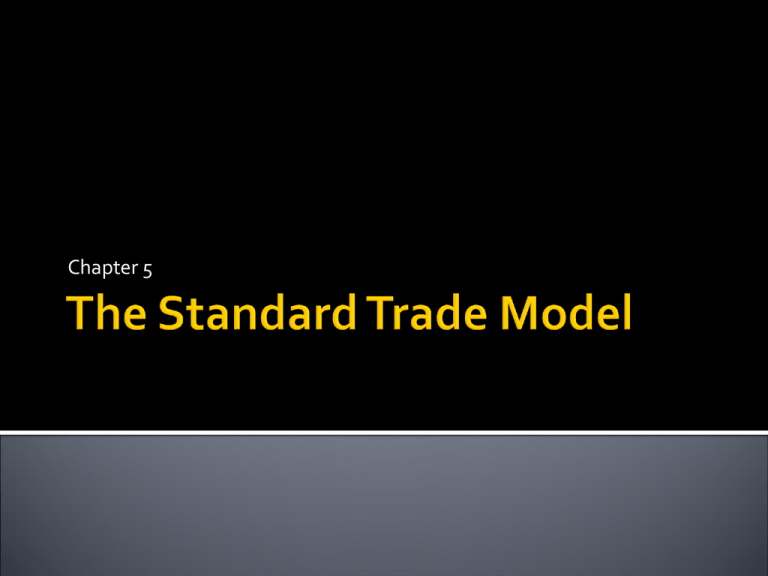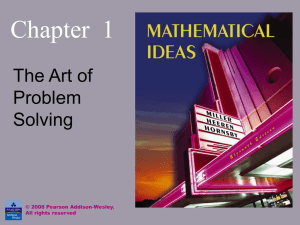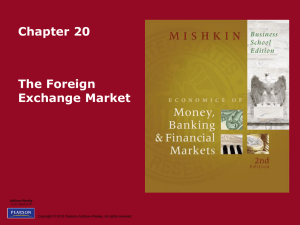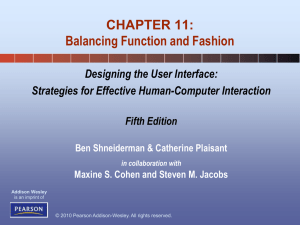
Chapter 5
A “generalized” model of trade
Issues:
Terms of trade and economic welfare
Trade and economic growth
International transfers
Import tariffs and export subsidies
Income distribution
Copyright © 2009 Pearson Addison-Wesley. All rights reserved.
5-2
The standard trade model combines ideas from the
Ricardian model and the Heckscher-Ohlin model.
Built on four key relationships:
PPF and relative supply
Relative prices and relative demand
Concept of a “world” equilibrium
Terms of trade (relative price of exports) and economic welfare
Copyright © 2009 Pearson Addison-Wesley. All rights reserved.
5-3
Recall from Chapter 4:
V = PCQC + PF QF = PCDC + PF DF
Economy’s production and consumption must lie on the
same isovalue line
Point of production: PPF tangent to isovalue line
Point of consumption: Indifference curve tangent to
isovalue line
Copyright © 2009 Pearson Addison-Wesley. All rights reserved.
5-4
Copyright © 2009 Pearson Addison-Wesley. All rights reserved.
5-5
Copyright © 2009 Pearson Addison-Wesley. All rights reserved.
5-6
Tastes, preferences and prices determine
consumption choices.
Consumer preferences are represented by
indifference curves: combinations of goods that
make consumers equally satisfied (indifferent).
Copyright © 2009 Pearson Addison-Wesley. All rights reserved.
5-7
Copyright © 2009 Pearson Addison-Wesley. All rights reserved.
5-8
Indifference curves are downward sloping: if consumption of
cloth decreases, then that of food must increase to keep the
consumer equally well-off
Indifference curves farther from the origin represent larger
quantities of food and cloth, which should make consumers
more satisfied: more is better than less
Indifference curves are flatter when moving to the right to
represent the fact that as more cloth and less food is
consumed, food becomes more valuable on the margin (and
vice-versa)
Copyright © 2009 Pearson Addison-Wesley. All rights reserved.
5-9
Prices also determine the value of consumption.
When the price of cloth rises relative to the price of food,
the economy is better off when it exports cloth: the
isovalue line becomes steeper and a higher indifference
curve can be reached.
A higher price for cloth exports means that more food can
be imported.
A higher relative price of cloth will also influence
consumption decisions about cloth versus food: a higher
relative price of cloth makes consumers willing to buy less
cloth and more food.
Copyright © 2009 Pearson Addison-Wesley. All rights reserved.
5-10
Copyright © 2009 Pearson Addison-Wesley. All rights reserved.
5-11
The change in welfare (income) when the price of
one good changes relative to the price of another is
called the income effect.
The income effect is represented by moving to a higher
indifference curve.
The substitution of one good for another when the
price of the good changes relative to the other is
called the substitution effect.
The substitution effect is represented by a moving along a
given indifference curve.
Copyright © 2009 Pearson Addison-Wesley. All rights reserved.
5-12
The terms of trade: price of exports relative to
the price of imports.
When a country exports cloth and the relative
price of cloth increases, the terms of trade increase or
“improve.”
Because a higher price for exports means that the
country can afford to buy more imports, an
increase in the terms of trade increases a
country’s welfare.
A decrease in the terms of trade decreases a
country’s welfare.
Copyright © 2009 Pearson Addison-Wesley. All rights reserved.
5-13
Copyright © 2009 Pearson Addison-Wesley. All rights reserved.
5-14
Is economic growth in other countries (ex. China)
good for the standard of living at Home (U.S.)?
Is growth in a country more or less valuable when it
when it is integrated in the world economy?
Copyright © 2009 Pearson Addison-Wesley. All rights reserved.
5-15
Growth is usually biased: it occurs in one sector
more than others, causing relative supply to
change.
Rapid growth has occurred in U.S. computer industries
but relatively little growth has occurred in U.S. textile
industries.
According to the Ricardian model, technological
progress in one sector causes biased growth.
According to the Heckscher-Ohlin model, an increase in
one factor of production (ex., an increase in the labor
force, arable land, or the capital stock) causes biased
growth.
Copyright © 2009 Pearson Addison-Wesley. All rights reserved.
5-16
Copyright © 2009 Pearson Addison-Wesley. All rights reserved.
5-17
Biased growth and the resulting change in relative supply
causes a change in a country’s terms of trade.
Biased growth in the cloth industry (in either the domestic or
foreign country) will lower the price of cloth relative to the price of
food and lower the terms of trade for cloth exporters.
Biased growth in the food industry (in either the domestic or
foreign country) will raise the price of cloth relative to the price of
food and raise the terms of trade for cloth exporters.
Suppose that the domestic country exports cloth and
imports food.
Copyright © 2009 Pearson Addison-Wesley. All rights reserved.
5-18
Copyright © 2009 Pearson Addison-Wesley. All rights reserved.
5-19
Export-biased growth: expands a country’s production
possibilities disproportionally that country’s export sector.
Biased growth in the cloth industry in the home country is export-
biased growth for the home country.
Import-biased growth: expands a country’s production
possibilities disproportionally in that country’s importcompeting sector.
Biased growth in food production in the home country is import-
biased growth for the home country.
Copyright © 2009 Pearson Addison-Wesley. All rights reserved.
5-20
Export-biased growth reduces a country’s terms of
trade, generally reducing its
welfare and increasing the welfare of
foreign countries:“immiserizing growth” (Bhagwati,
1958).
Import-biased growth increases a country’s terms of
trade, generally increasing its
welfare and decreasing the welfare of
foreign countries.
Copyright © 2009 Pearson Addison-Wesley. All rights reserved.
5-21
The standard trade model predicts that import biased growth
in China reduces the U.S. terms of trade and the standard of
living in the U.S.
Import biased growth for China would occur in sectors that compete
with U.S. exports.
This prediction is not supported by data
In fact, changes in the terms of trade for high income countries have
been positive and negative for developing Asian countries.
Copyright © 2009 Pearson Addison-Wesley. All rights reserved.
5-22
Copyright © 2009 Pearson Addison-Wesley. All rights reserved.
5-23
War reparations or foreign aid (official
development assistance) may influence demand
for traded goods and therefore relative demand.
International loans may also influence relative
demand in the short run (before the loan is
paid back).
How do transfers of income across countries
affect terms of trade and welfare?
Copyright © 2009 Pearson Addison-Wesley. All rights reserved.
5-24
At the end of World War I, the Allied countries
demanded substantial war reparation payments
from Germany
Question: who would benefit from this transfer of
income? How would it affect terms of trade (and
welfare) of Germany and the Allied countries?
Led to a heated debate between John Maynard
Keynes and Bertil Ohlin in 1929: the origin of the
“transfer problem.”
Copyright © 2009 Pearson Addison-Wesley. All rights reserved.
5-25
Keynes:
To pay for the transfer, Germany must export more and
import less
This would make German exports cheaper than imports
worsen German terms of trade
The worsening terms of trade would add to the direct
burden of the transfer and make Germany unambiguously
worse-off
An international transfer makes the donor worse-off and
the recipient better-off.
Copyright © 2009 Pearson Addison-Wesley. All rights reserved.
5-26
Ohlin:
To pay for the transfer, Germany must raise taxes
This would reduce demand for foreign goods
The transfer would be distributed in the Allied countries
through government spending or lower taxes
This would raise demand for German exports
Transfers do not affect terms of trade
In the end, Germany paid very little of the
demanded reparations
Copyright © 2009 Pearson Addison-Wesley. All rights reserved.
5-27
The critical question: do spending propensities differ
across the donor and recipient?
If both countries have identical marginal propensities to
spend on exports and imports, then transfers should not
affect terms of trade and welfare (Ohlin)
However, if spending propensities differ across
countries, a transfer might affect the composition of
world demand, and affect the terms of trade (Keynes)
Copyright © 2009 Pearson Addison-Wesley. All rights reserved.
5-28
Suppose Home has a higher propensity to
spend on cloth (its export good) than foreign,
and foreign has a higher propensity to spend
on food than home
If Home makes a transfer payment to
Foreign,
What happens to the world relative demand for
cloth?
What happens to Home’s TOT?
Copyright © 2009 Pearson Addison-Wesley. All rights reserved.
5-29
Copyright © 2009 Pearson Addison-Wesley. All rights reserved.
5-30
But if Home has a lower propensity to spend on
cloth than foreign, then Home’s TOT may improve
by making a transfer
In general: a transfer makes a donor worse-off if it
has a higher marginal propensity to spend on its
export good than the recipient
The Transfer Paradox: a transfer could make the
donor better-off and the recipient worse-off it is
better to give than to receive!
Copyright © 2009 Pearson Addison-Wesley. All rights reserved.
5-31
Transfer amount (from Home to Foreign) is $1
Home: MPS on cloth = 0.40; MPS on food = 0.60
Foreign: MPS on cloth =0.60; MPS on food = 0.40
Home (-$1)
Foreign (+$1)
Net World
Demand
Exp on cloth
-0.40
+0.60
+0.20
Exp on food
-0.60
+0.40
-0.20
-1
+1
Total
World relative demand for cloth increases and Home’s TOT
improve and Foreign’s worsen
Copyright © 2009 Pearson Addison-Wesley. All rights reserved.
5-32
Import tariffs are taxes levied on imports
Export subsidies are payments given to domestic
producers that export.
Both policies influence the terms of trade and
therefore national welfare.
Copyright © 2009 Pearson Addison-Wesley. All rights reserved.
5-36
Import tariffs and export subsidies drive a wedge
between prices in world markets (or external prices)
and prices in domestic markets (or internal prices).
Since exports and imports are traded in world markets, the
terms of trade measures relative external prices.
Copyright © 2009 Pearson Addison-Wesley. All rights reserved.
5-37
If the domestic country imposes a tariff on food imports, the
price of food relative to price cloth that domestic individuals
and institutions face rises.
Likewise, the price of cloth relative to the price of food that domestic
individuals and institutions face falls.
Domestic producers will receive a lower relative price of cloth, and
therefore will be more willing to switch to food production: relative
supply will decrease.
Domestic consumers will pay a lower relative price of cloth, and
therefore be more willing to switch to cloth consumption: relative
demand will increase.
Copyright © 2009 Pearson Addison-Wesley. All rights reserved.
5-38
Copyright © 2009 Pearson Addison-Wesley. All rights reserved.
5-39
When the domestic country imposes an import tariff, the
terms of trade increases and the welfare of the country may
increase.
The magnitude of this effect depends on the size of the
domestic country relative to the world economy.
If the country is small part of the world economy, its tariff (or subsidy)
policies will not have much effect on world relative supply and
demand, and thus on the terms of trade.
But for large countries, a tariff rate that maximizes national welfare at
the expense of foreign countries may exist.
Copyright © 2009 Pearson Addison-Wesley. All rights reserved.
5-40
If the domestic country imposes a subsidy
on cloth exports, the price of cloth relative to
price food that domestic individuals and
institutions face rises.
Domestic producers will receive a higher relative price
of cloth when they export, and therefore will be more
willing to switch to cloth production for export: relative
supply will increase.
Domestic consumers must pay a higher relative price of
cloth to producers who have the option of exporting,
and therefore will be more willing to switch to food
consumption: relative demand will decrease.
Copyright © 2009 Pearson Addison-Wesley. All rights reserved.
5-41
Copyright © 2009 Pearson Addison-Wesley. All rights reserved.
5-42
When the domestic country imposes an export
subsidy, the terms of trade decreases and the
welfare of the country decreases to the benefit of
the foreign country.
Copyright © 2009 Pearson Addison-Wesley. All rights reserved.
5-43
Because of changes in relative prices,
import tariffs and export subsidies have effects on
income distribution among producers within a
country.
Copyright © 2009 Pearson Addison-Wesley. All rights reserved.
5-47
Generally, a domestic import tariff increases income for
domestic import-competing producers by allowing the price
of their goods to rise to match increased import prices, and it
shifts resources away from the export sector.
Generally, a domestic export subsidy increases income for
domestic exporters, and it shifts resources away from the
import-competing sector.
Copyright © 2009 Pearson Addison-Wesley. All rights reserved.
5-48
1.
A change in relative prices, say due to trade, causes an
income effect and a substitution effect.
2.
The terms of trade refers to the price of exports relative
to the price of imports in world markets.
3.
Export-biased growth reduces a country’s terms of trade,
generally reducing its welfare and increasing the welfare
of foreign countries.
4.
Import-biased growth increases a country’s terms of
trade, generally increasing its welfare and decreasing the
welfare of foreign countries.
Copyright © 2009 Pearson Addison-Wesley. All rights reserved.
5-49
5.
The effect of international transfers of income
depend on the marginal propensity to spend on
domestic goods, but generally the relative demand
of a donor will decrease with such transfers,
causing a decrease in its terms of trade.
6.
When the domestic country imposes an import
tariff, its terms of trade increases and its welfare
may increase.
Copyright © 2009 Pearson Addison-Wesley. All rights reserved.
5-50
7.
When the domestic country imposes an export
subsidy, its terms of trade decreases and its
welfare decreases.
8.
Generally, a domestic import tariff increases
income for domestic import-competing
producers and shifts resources away from the
export sector.
9.
Generally, a domestic export subsidy increases
income for domestic exporters
and shifts resources away from the
import-competing sector.
Copyright © 2009 Pearson Addison-Wesley. All rights reserved.
5-51
Additional Chapter Art
Copyright © 2009 Pearson Addison-Wesley. All rights reserved.
5-52
Copyright © 2009 Pearson Addison-Wesley. All rights reserved.
5-53
Copyright © 2009 Pearson Addison-Wesley. All rights reserved.
5-54
Copyright © 2009 Pearson Addison-Wesley. All rights reserved.
5-55
Copyright © 2009 Pearson Addison-Wesley. All rights reserved.
5-56







